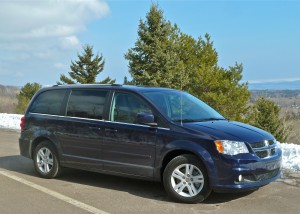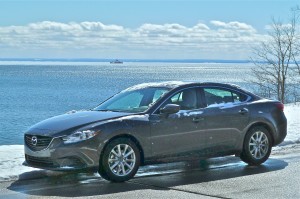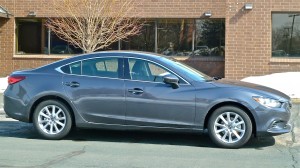Even 6-figure BMW 750iXL halted by ice, tires
By John Gilbert
Remind me, someone, to plead with the press-fleet powers at BMW to send me the new BMW 750iL for a second test-drive week, after the persistent snow and ice of this never-ending winter finally cash in their chips. As it is, the chance to experience the many wonderful features of the car, which is BMW’s flagship of luxury and class, was undone by a couple of snowstorms and some easy-slip tires.
It’s not as though I didn’t get a chance to test the 750 extensively. All the things I experienced with the car were very impressive, even for a car whose sticker price topped the $118,000 mark. As usual, the lofty price of a BMW can also be said to be worth it, based on the level of technical refinement and engineering brilliance. This car had the 4.4-liter V8, with more power than any normal driver could ever need, and all the luxury features imaginable, and a few beyond imagination.
But one characteristic out of the car-maker’s control was a major flaw, in the Great White North. The tires BMW put on the car were Pirelli P7 Cinturato by designation, and I know from past experience they are among the very best tires in the world on dry pavement, and for high-speed maneuvering. My past experience with those tires in Minnesota winter driving is less extensive, limited to the BMW X1 crossover, and in both cases, the low-profile beauty of those tires, and their ability to stick like glue to a dry track at high speed, became the farthest thing from a driver’s mind after a snowstorm.
As i was driving the 750, I couldn’t help but be reminded of the huge snowfall that hit the Northeast back in late February, I think it was, burying much of Massachusetts, New Hampshire and points north under 27 inches or snow of snow. A storm of that magnitude would be incredible wherever it happened, but it wouldn’t have commanded the national news and weather programs on network and satellite. Every time you turned on the television, you couldn’t escape the newscasters, inside their parkas, doing their obligatory reports while standing outside during the most intense parts of the blizzard.
A woman on either CNN or The Weather Channel was in a convenience store/gas station parking lot, and the swirling snow in the background made it appear to be on the edge of the Arctic Circle. She noted a car behind her spinning helplessly and unable to get out of the unplowed lot. Finally, two or three large fellows pushed and pushed and finally the free-spinning Acura TL got enough momentum to disappear out on the streets. Moments later, a subcompact, possibly a Nissan Versa or Toyota Yaris, came around the gas pumps and went by, covered with snow, and also spinning its front drive-wheels. “Here comes a little tiny car,” she said, “which, of course, will have no chance getting through this snow because it’s so light.” With that, the little car kept on churning and made it on out of the lot.
Tires matter. True, they matter for high-performance speed and cornering, and they also matter to the mainstream for long wear and smooth cruising. But they matter most in order to propel your car safely through the worst of foul-weather storms, where going off the road or being unable to get to your destination can leave you marooned. And the tires that work in one extreme condition are completely unsuited for the other extreme. Being stationed in Northern Minnesota, where such winter storms are common — and seem to be never-ending well into April of this particular year — even untrained drivers are aware of the need to get traction in wintry driving, which is mandatory for getting to work, if not simple survival. For the rest of the world, or our country, the masses may be totally unaware of the importance of worthy all-season or snow tires. And national reports on television that are erroneous don’t help.
The Acura TL in the live shot, for example, has front-wheel drive, but may well have had the factory-issue Michelin tires that are so good in dry weather and for long wear, but have a hard compound that refuses to earn traction on ice or snow. And the woman’s editorial comment about how “little cars” have no chance of getting through prove that not only experience but a shred of common sense is important before claiming that a cars size and weight is all that matters. The small car in question had front-wheel drive too, and even though it’s light, it has its weight centered over the drive wheels, and with adequate all-season tires it can keep churning on icy roads or deep snow.
I’m not blaming The Weather Channel for sending out an attractively snowbanked, on-the-scene reporter who was unaware that the right tires can make a front-wheel-drive car get through such conditions, regardless of its weight, but to issue such misleading statements is as ill-advised as it would be to ask me for an impromptu comment on the difference between an occluded front and that Alberta Clipper coming down from the northwest. Read more
Grand Caravan achieves objectives better than ever
By John Gilbert
It’s time for minivans to rise up and claim their rightful place at the top of the family vehicle chain.
You’ve got to pity the poor minivan. Everybody who owns one appreciates it, to the point of wondering how their families could ever get along without it. But it is universally scorned, to the point of acting as though they’d never consider buying one, and even some of those who own them keep it hidden and only take it out when the kids need to haul a hockey or soccer team full of buddies to the next practice or game.
It wasn’t always that way. When the Dodge Caravan was at its peak, it seemed as though everybody had one and everybody who did loved to show them off. Essentially, minivans were the vehicles that drove station wagons to extinction. But after several decades of loyal, trustworthy, and efficient transportation, in all weather, minivans also led directly to the derision that might be called “Soccer mom syndrome.” Minivans didn’t seem all that macho, so men would always say they got the minivan for their wives, who had to haul kids to practices and games.
Meanwhile, sport utility vehicles became the vehicle that did to minivans what minivans had done to station wagons, and it although minivans kept selling, they almost had to be hidden over in the dark corner of the dealership, or left on the back lot, and delivered in a plain, brown wrapper. Read more
Mazda6 adds style, Skyactiv for 2014
By John Gilbert
The Mazda 626 has always been a worthy midsize entry, just as dependable, and sportier, though less-heralded, than midsize segment leaders Honda Accord, Nissan Altima and Toyota Camry. When it was renovated into the Mazda6, it moved higher on the artistic list and had an edge in sporty handling, but still didn’t match the hot-selling numbers of its competitors. Its last restyling,took the Mazda6 to a much more flowing look, although like the Accord it became large enough to be too large for some midsize buyers.
For 2014, Mazda has introduced another all-new Mazda6, and it appears to connect on all (four) cylinders. It has outdone all previous models in styling and technology, with styling that has a strong resemblance to recent auto show Mazda concept vehicles, and performance from its Skyactiv powertrain technology.
The styling, Mazda officials say, captures the muscular energy of a lion or cheetah as it tenses up to pounce, a compelling idea that inspired the Kodo concept car. The tight lines are attractive, none moreso than the contour that arches above the front wheel openings before blending into the flanks.
Its engineering starts with Skyactiv, which has made Mazda the first Japanese manufacturer to discard its well-engineered array of engines in favor of entirely revised engine technology, focused on the future while easily topping current demands.
A recent test-drive of the 2014 model in the later stages of Minnesota winter indicates that the front-wheel-drive Mazda6 has made direct hits on its multiple targets of style, comfort, versatility, performance and technology. Amazingly, if the test vehicle I drove had listed at $30,000, I would have thought it was worth it; instead, it listed for just over $20,000 — a remarkable bargain.
As for sales volume, Mazda is a quick welterweight boxing against a ring-full of heavyweights. Toyota, Honda and Nissan are focused on massive sales, while Mazda seems content to be a niche player, focusing on changing directions more efficiently to be stay after its image of technology, performance, and the now-familiar “zoom-zoom” philosophy of building cars that are fun to drive. Read more






 John Gilbert is a lifetime Minnesotan and career journalist, specializing in cars and sports during and since spending 30 years at the Minneapolis Tribune, now the Star Tribune. More recently, he has continued translating the high-tech world of autos and sharing his passionate insights as a freelance writer/photographer/broadcaster. A member of the prestigious North American Car and Truck of the Year jury since 1993. John can be heard Monday-Friday from 9-11am on 610 KDAL(www.kdal610.com) on the "John Gilbert Show," and writes a column in the Duluth Reader.
John Gilbert is a lifetime Minnesotan and career journalist, specializing in cars and sports during and since spending 30 years at the Minneapolis Tribune, now the Star Tribune. More recently, he has continued translating the high-tech world of autos and sharing his passionate insights as a freelance writer/photographer/broadcaster. A member of the prestigious North American Car and Truck of the Year jury since 1993. John can be heard Monday-Friday from 9-11am on 610 KDAL(www.kdal610.com) on the "John Gilbert Show," and writes a column in the Duluth Reader.